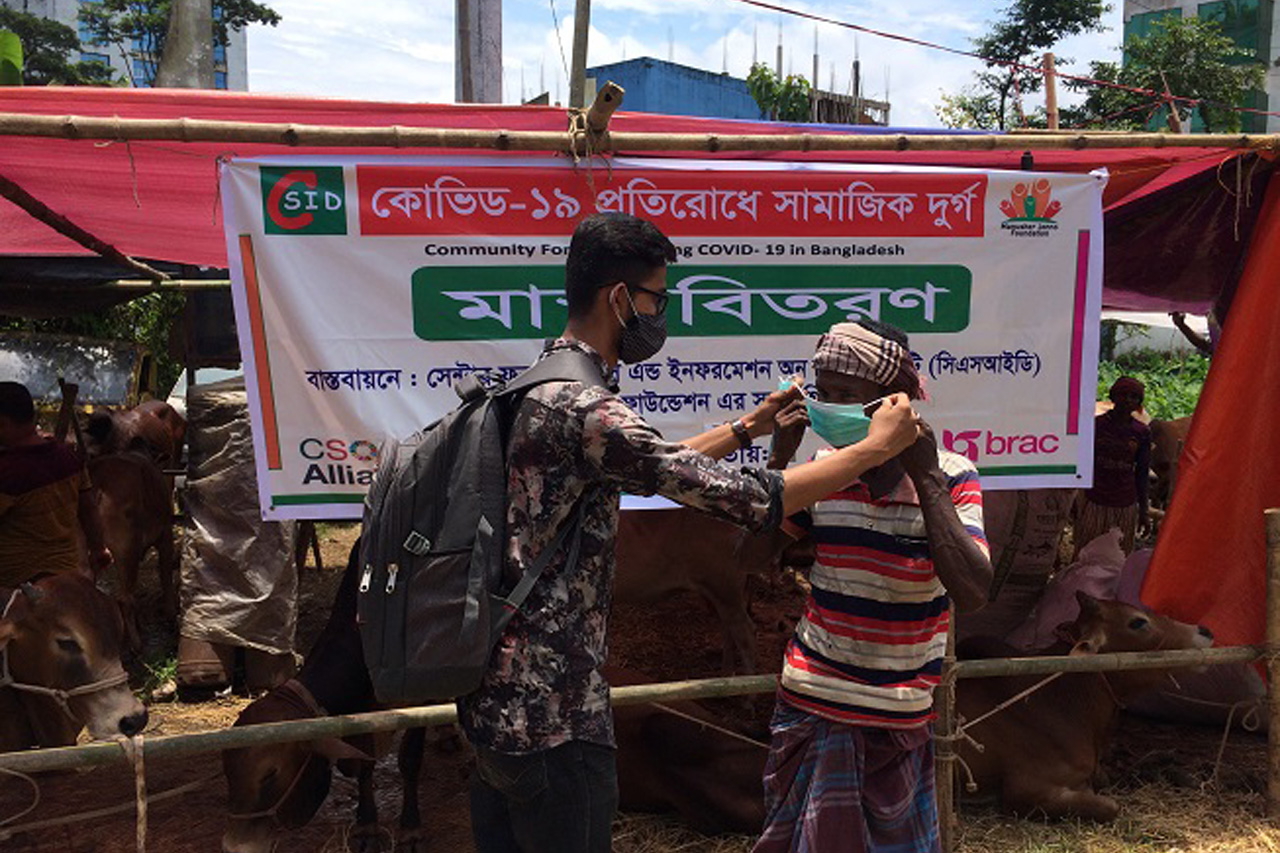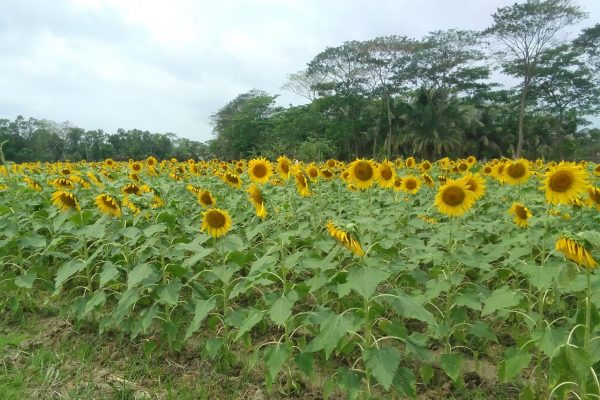Building rural forts of resistance against COVID-19: What we are learning in Bangladesh
Reading Time: 6 minutes
The Community Fort for Resisting COVID-19 project is a protracted effort to contain the virus within communities in Bangladesh, by equipping 81 million people across 35 high-risk districts with the tools and knowledge to keep themselves and their families safe. The project is implemented by a coalition of organisations who work at the community level. BRAC sat down with one of the partners, Manusher Jonno Foundation, to get an update on what they are learning:
Lockdowns are being implemented around the world to contain COVID-19 cases. In a country where 87% of the labour force is employed in the informal sector though, staying home for indefinite periods of time is simply not possible. In Bangladesh, misinformation regarding the virus is rampant, and mask-wearing has not become a habit yet for many. Cramped living conditions in informal settlements and the cost of hygiene items make it even more difficult for people in low-income communities to maintain health guidelines.
Read more: COVID-19 in Bangladesh: Update from Asif Saleh (31 July 2021)
BRAC is supporting communities across Bangladesh to lead the fight against COVID-19, through the Community Fort for Resisting COVID-19 project (‘CFRC’ hereafter). The project is supported by four pillars to tackle the pandemic: fighting misinformation, promoting mask-wearing, responding to infections, and promoting vaccination, and has been working to reach 81 million people across 35 out of Bangladesh’s 64 districts since 1 June, 2021. The project was launched in partnership with CSO Alliance under the leadership and guidance of the government’s Directorate General of Health Services.

Manusher Jonno Foundation (Foundation for the People; ‘MJF’ hereafter), one of the largest national grant-making organisations in Bangladesh, is a key partner in the project. With over 110 partner organisations across the country, MJF has been active for two decades. BRAC sat down with MJF’s programme manager Mohammad Zahed Hasan:
Some of the hardest-hit districts have recorded positivity rates as high as 60%. What are the reasons behind this rise?
There is one major reason behind the rise in infections, particularly in Jashore, Khulna, Satkhira and Chuadanga – these are adjacent to India, where the Delta variant has wreaked havoc. BRAC chose to prioritise these areas because the situation is alarming. Right now, there is someone with a fever in almost every household, and many households are choosing not to get tested – so the overall positivity rates may be even higher. Public health management at the local level is under immense pressure.
Many people living in these border area districts often travel to India for their livelihoods. Fisherfolk, farmers, small-scale traders and business owners have regular transactions with the other side of the border. That, paired with low levels of community awareness and dependence on day-to-day income, has contributed to the spread.
Read more: How do we build forts of resistance against COVID-19?
Millions of workers in the informal sector fear losing their incomes during lockdowns. Is strengthening communities a better alternative for prolonged protection?
Lockdowns are an excellent measure to contain the spread, but they are not viable long-term. COVID-19 is here to stay; we have to come up with solutions. Masking and vaccination are the two principal ways to build resilience.
Considering the huge number of citizens that work in the informal sector, strengthening their communities and teaching them the necessity of masking and vaccination is a better alternative to threatening their livelihoods with a lockdown.
Our goal is to make sure communities in high-risk areas can identify risks and know what they need to tackle those risks. We are not only equipping them with the right tools but also bringing them accurate information on the virus and the severity of the pandemic.
How can we ensure sustainable improvement in behaviour and habits regarding mask-wearing and handwashing?
The high-risk communities in border-adjacent districts have responded fairly well to the project. Since our field staff are from the community themselves, they are better suited to understand people’s hesitation, build trust, and convince them to wear masks and wash their hands regularly. We are also reinforcing this with communication materials such as billboards and posters in public spaces.
Last year, the cities of Bangladesh were heavily affected by COVID-19. Since the infections have spread in large numbers across villages now, the rural populations have gradually begun to understand the risks associated with not following the health guidelines. Yet many people live in poverty or have low incomes, and cannot afford to buy masks. The project is distributing masks for free. Ultimately, we must subsidise masks and make sure every person wears one. We are convincing people that there is truly no better alternative to masks. To establish a permanent change in behaviour, we have to follow up regularly on these conversations and reinforce our messaging constantly.

Which misconceptions were present in communities regarding COVID-19 and vaccinations, and how should people be approached to clear these up?
A lot of people think that vaccines are only for children. Some fear the vaccines would cause health issues. Others believe that ‘they are just injecting water’. Many have said they would rather not take the vaccine because birth and death are only in the control of the almighty. We have even seen people forgo masks with this logic.
We are fighting these ideas and helping people to register for vaccination when they are eligible. But there is still a long way to go. Masking has to continue even after inoculation, and we are just making progress on getting people habituated to wearing masks.
As the state brings in more vaccines, we will keep encouraging people to get the shots by targeting public hubs such as marketplaces and unions for awareness messaging. Street theatres and video screenings work well to get people to understand how vaccines work. I also would not undermine the power of celebrities for public health messaging over television and radio.
Mass vaccination requires efforts from all corners. Public and private sector players, community leaders and everyday citizens must clear any misconceptions they come across among any of their loved ones or acquaintances and encourage everyone to get the shots.
What have been the biggest challenges in implementing the project?
At the beginning of the pandemic, we saw a lot of humanitarian initiatives from individuals and organisations. Despite the good intentions, those initiatives of mask distribution were not big enough in scale (Bangladesh has a population of 163 million), nor were they paired with sustained behaviour change activities. After a few weeks, they died down. Under CFRC, alongside providing people the tools i.e., masks to protect themselves, we are also attempting to bring sustained change in their habits by making them aware about the risks associated with not wearing a mask. Our resources, however, are quite limited at the moment. We are only giving two masks to each household – which does not cover every member of the average-sized family, especially in rural communities. Masks are the only thing that can physically prevent infection. People understand that now, but we have not been able to meet the demand for them yet.
Read more: How can behavioural insights help us to increase handwashing?
Another challenge is coordinating between influential local leaders. Our partner NGOs strategically work with these leaders to ensure the project is not hindered.
Incentivising volunteers to visit communities and raise awareness is a continuing challenge. Our partner NGOs are working with the available resources, but oftentimes, it gets difficult to keep field workers motivated to take up humanitarian work during such devastating crises.
And finally, truly changing behaviour is the most difficult challenge. Often we will provide a mask and teach people how to use it, but they take it home and cherish it as a household item rather than a tool to protect themselves. That being said, the relentless work on these matters under the project have already come a long way. I believe we are getting through to more and more people as the project progresses.
BRAC has been fighting COVID-19 using its Community Support Team (CST+) model since the beginning of the pandemic. What new impact are we seeing through the addition of the CFRC project, and what strengths does MJF add to this initiative?
The CST+ model’s strength is in its collaborative nature – it brings together BRAC’s health workers and utilises DGHS and a2i’s resources for a well-rounded approach to identifying and treating COVID-19.
CFRC engages communities on a deeper level, empowering them to take matters into their own hands to keep themselves safe from COVID-19. Ultimately, people live and learn within and from their communities, so this was a much-needed addition to the original model.
Read more: Community-based healthcare for COVID response: option or necessity?
MJF brings its primary strength of partnerships to this approach. We have 110 partner organisations all over Bangladesh, many of which are working on the CFRC project. Local NGOs such as Bagura’s Lighthouse, Jashore’ Bachte Shekha and Satkhira’s Uttaran are highly influential in their respective areas. Now that they have BRAC’s support via MJF, these NGOs have a stronger footing at the local level.
Direct channels of communication have opened up among all parties – local government, local NGOs, MJF and BRAC – leading to quicker implementation and more targeted interventions among communities.
Can prevention, masking, response and vaccination, paired with sustained change in people’s behaviour, prevent another wave of COVID-19 in Bangladesh?
When we deliver masks, people demand more. As we fight misinformation, more people feel safer enough to take a COVID-19 test or get vaccinated, and the demand for better testing, healthcare and vaccine rollouts becomes apparent. These issues are all connected. We have to cater our strategies to what communities need. Upazila health centres must be strengthened and testing facilities have to be increased. We need trained health workers and more masks to meet the demand.
Behaviour change cannot happen overnight, and we are not aiming for it either. We also cannot think of these four pillars as isolated steps – these must continue simultaneously to tackle interconnected issues presented by the pandemic. If implemented correctly, these four pillars can help us avoid lockdowns altogether, and definitely ensure sustained safety from COVID-19.
BRAC’s Community Fort for Resisting COVID-19 project is being carried out in 35 high-risk districts and is funded by Global Affairs Canada, Embassy of Switzerland, HBCC, Unilever and UKaid. BRAC has also launched the Dakche Abar Desh (‘Bangladesh calls again’) campaign to support families hit the hardest by the pandemic. Grameenphone has joined hands, as have several commercial banks under their special CSR programmes, to contribute to this campaign.





